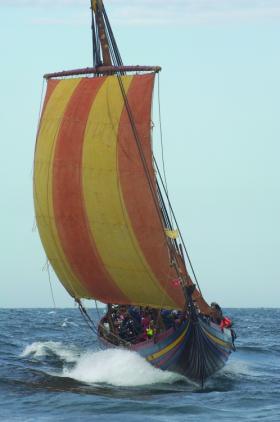The Sea Stallion from Glendalough
Published in 20th-century / Contemporary History, Issue 5 (Sep/Oct 2007), News, Volume 15
On 14 August 2007 a Viking longboat arrived in Dublin amidst much fanfare. While this would have been fairly unremarkable during Dublin’s heyday as a Viking trading port, in 2007 the novelty of the event guaranteed crowds of onlookers, an army band, at least one overly enthusiastic traffic cop and numerous public representatives. The longboat was supposed to have been escorted into the port by the LE Roisin but, thanks to engine trouble, a large ugly tug did the job instead.
The Sea Stallion from Glendalough had sailed to Dublin from Roskilde in Denmark, a replica of a Viking longboat that had sailed in the opposite direction in the eleventh century. The vessel on which the Sea Stallion was based was built in or near Dublin c. 1042, using wood from Glendalough (hence the name). It was the largest of five longships scuttled near the village of Skuldalev some 30 years later in order to block Norwegian raids into Roskilde Fjord. The original, Skuldalev 2, was at the cutting edge of contemporary Viking shipbuilding, and the Sea Stallion was built using the original techniques. The project was organised by Roskilde’s Viking Ship Museum. Work began in 2000, and in 2004 the 30m-long vessel was launched. Officially described as ‘the biggest experimental archaeological project ever’, over seven weeks the Sea Stallion and its crew of 65 hardy souls sailed to Dublin via the Orkneys. It is a unique and hugely ambitious experiment intended to recreate a maritime experience from the early Middle Ages: a period when hundreds, if not thousands, of similar vessels plied the sea routes that tied together the scattered Viking seafaring world. The information gathered on the Sea Stallion’s voyage will form the basis for an educational programme intended to shed even more light on the reality of that Viking world. And you can see it right here in Dublin.
The longboat docked beside the Financial Services Centre, but it was difficult to see at close quarters. On the other hand, there was room on dry land for various stalls and displays, with characters in Viking dress showing off Viking activities, crafts and foods. As raiders who became traders, the Vikings were the original Celtic Tiger capitalists, and in a touch that seemed accidentally appropriate one of the ‘Vikings’ taking the money at the stalls was wearing a very sharp suit. Amidst much talk of culture and commerce, the

whole event was an excellent reminder for people to go and visit the Viking-related sites of Ireland before more things get built on top of them. And for those who didn’t want to get eyestrain on the day, the Sea Stallion was lifted out of the water two days later to be transported to the National Museum at Collins Barracks, where it will be a showcase exhibit on dry land for the coming year before completing its round trip via the English coast and returning to Roskilde next summer.
John Gibney is an IRCHSS Government of Ireland fellow at the Moore Institute for Research in the Humanities and Social Studies, NUI Galway.
















